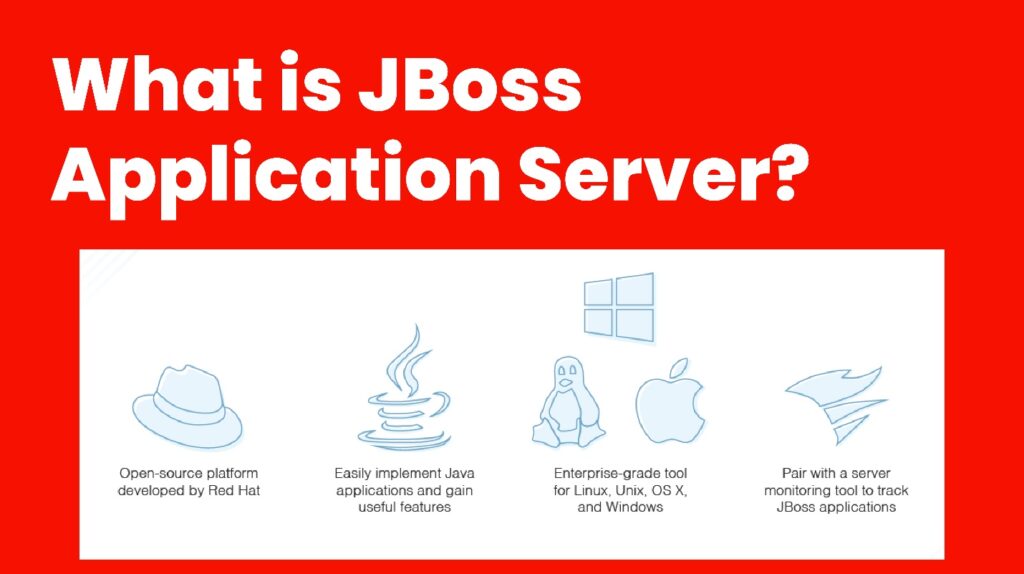What is JBoss Application Server?
The Java Enterprise Edition (EE) specification is handled by JBoss Application Server, a J2EE application server. Red Hat is the developer and operator of the accessible program JBoss. The JBoss AS community release, which supports JTA, EJB, JPA, servlets, JSP, and other common Java EE technologies, is available for free download and use. JBoss Enterprise Application Platform, a for-profit offering that offers extra functionality and support, is another way to access JBoss AS. Both on-premises and cloud implementations of JBoss EAP are compatible for use in production deployments. Any J2EE application will run on the standards-compliant application server JBoss AS. JBoss AS also offers extensive administration features and a wide range of plugins that increase its capability.
History of JBoss Application Server
Marc Fleury initially developed JBoss Application Server as an open-source undertaking dubbed EJB-OSS in 1999. JBoss Group LLC was established in 2000 to provide for the application server’s commercial support. Red Hat purchased JBoss in 2006, and since then, the product has continued to advance and grow. JBoss AS 7.1 is the most recent version.
Features of JBoss Application Server

For programmers and network administrators, the JBoss server offers a variety of capabilities that make it a desirable choice. Among the essential characteristics are:
- A wide range of Java EE technologies is supported.
- High efficiency
- Reliability
- Support for clustering
- the load balancing
- Dynamic scaling
- Simple administrative interface
Related Article: Tomcat vs JBoss: Compare features to use these java app servers
Use cases for JBoss Application Server
There are a few use cases of JBoss Application Server, most of which revolve around its capacity to handle popular Java EE specifications:
- JBoss AS can host Java Server Pages (JSP) and servlets-based dynamic websites and web applications when used as a web server.
- Enterprise Java applications can operate on a runtime environment provided by JBoss AS, which can host EJB 3.0 beans.
- Using as an application client container, Jboss can support Java applications that access distant EJBs.
- As a framework for dependable connectivity between apps, JBoss AS can also act as a communication server.
How to install JBoss Application Server?

JBoss is frequently used for web-based applications and has a sizable user and developer community. The most recent version of JBoss, JBoss AS 2022, is simple to install and configure. We will cover the procedure required to install JBoss on the system in this guide.
The JBoss installer must first be downloaded from the JBoss website. Go to the JBoss bin directory after unzipping the file. Run the standalone.bat file for Windows or the standalone.sh file for Linux from this point on. The JBoss server will launch as a result. Visit the administrative interface at http://localhost:9990/admin-console/ once JBoss has launched.
You must log in with the username and password you chose at installation.
You can now launch your apps to the server after installing JBoss. Using the administrative console or by placing your program files into the JBOSS HOME/standalone/deployments directory, JBoss makes it simple to deploy apps. JBoss will immediately deploy any apps copied into this directory.
How to deploy an application on JBoss Server?
Java EE applications can be deployed using JBoss AS. Deploying an application on JBoss is a quick and easy procedure that only involves a few steps.
You must copy the application files into the JBOSS HOME/standalone/deployments directory. Any new files added to this directory will be automatically discovered by JBoss, who will then deploy them.
Go to the Deployments tab and click the Add button to deploy your application using the JBoss management console.
Click OK after selecting your application file in the ensuing dialogue box.
The JBoss Application Server will now deploy your application.
How to undeployed an application from JBoss Server?
Click on the Deployments tab in the administrative console to start the process of underlying an application from JBoss.
To remove a deployment, check the box beside its name.
The Undeployed button will appear at the bottom of the page. Click it.
Click the Undeployed button in the ensuing dialogue box to confirm your decision.
The JBoss Application Server will now stop serving your application.
How to create a data source in JBoss AS?
JBoss AS supports numerous databases. You must first build a data source before you can connect to a database. You can construct a data source for the MySQL database in JBoss AS 7.1 by following the instructions in the steps below.
Click the Add button after going to the Data sources tab in the administration console.
Click OK after selecting MySQL in the ensuing dialogue box.
In the subsequent form, fill out the necessary details for your database connection, then click Save.
You can now use your newly established data source to connect to your database.
Conclusion
JBoss Application Server is a flexible tool to apply for numerous tasks. Using JBoss AS 7.1, this guide has demonstrated how to install, deploy, and undeployed apps. In JBoss AS 7.1, you have also learned how to construct a data source.
